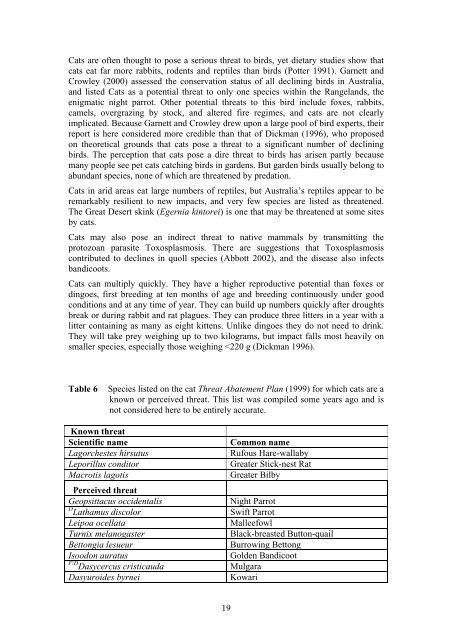Review of the management of feral animals and their impact on ...
Review of the management of feral animals and their impact on ...
Review of the management of feral animals and their impact on ...
You also want an ePaper? Increase the reach of your titles
YUMPU automatically turns print PDFs into web optimized ePapers that Google loves.
Cats are <str<strong>on</strong>g>of</str<strong>on</strong>g>ten thought to pose a serious threat to birds, yet dietary studies show that<br />
cats eat far more rabbits, rodents <str<strong>on</strong>g>and</str<strong>on</strong>g> reptiles than birds (Potter 1991). Garnett <str<strong>on</strong>g>and</str<strong>on</strong>g><br />
Crowley (2000) assessed <str<strong>on</strong>g>the</str<strong>on</strong>g> c<strong>on</strong>servati<strong>on</strong> status <str<strong>on</strong>g>of</str<strong>on</strong>g> all declining birds in Australia,<br />
<str<strong>on</strong>g>and</str<strong>on</strong>g> listed Cats as a potential threat to <strong>on</strong>ly <strong>on</strong>e species within <str<strong>on</strong>g>the</str<strong>on</strong>g> Rangel<str<strong>on</strong>g>and</str<strong>on</strong>g>s, <str<strong>on</strong>g>the</str<strong>on</strong>g><br />
enigmatic night parrot. O<str<strong>on</strong>g>the</str<strong>on</strong>g>r potential threats to this bird include foxes, rabbits,<br />
camels, overgrazing by stock, <str<strong>on</strong>g>and</str<strong>on</strong>g> altered fire regimes, <str<strong>on</strong>g>and</str<strong>on</strong>g> cats are not clearly<br />
implicated. Because Garnett <str<strong>on</strong>g>and</str<strong>on</strong>g> Crowley drew up<strong>on</strong> a large pool <str<strong>on</strong>g>of</str<strong>on</strong>g> bird experts, <str<strong>on</strong>g>the</str<strong>on</strong>g>ir<br />
report is here c<strong>on</strong>sidered more credible than that <str<strong>on</strong>g>of</str<strong>on</strong>g> Dickman (1996), who proposed<br />
<strong>on</strong> <str<strong>on</strong>g>the</str<strong>on</strong>g>oretical grounds that cats pose a threat to a significant number <str<strong>on</strong>g>of</str<strong>on</strong>g> declining<br />
birds. The percepti<strong>on</strong> that cats pose a dire threat to birds has arisen partly because<br />
many people see pet cats catching birds in gardens. But garden birds usually bel<strong>on</strong>g to<br />
abundant species, n<strong>on</strong>e <str<strong>on</strong>g>of</str<strong>on</strong>g> which are threatened by predati<strong>on</strong>.<br />
Cats in arid areas eat large numbers <str<strong>on</strong>g>of</str<strong>on</strong>g> reptiles, but Australia’s reptiles appear to be<br />
remarkably resilient to new <str<strong>on</strong>g>impact</str<strong>on</strong>g>s, <str<strong>on</strong>g>and</str<strong>on</strong>g> very few species are listed as threatened.<br />
The Great Desert skink (Egernia kintorei) is <strong>on</strong>e that may be threatened at some sites<br />
by cats.<br />
Cats may also pose an indirect threat to native mammals by transmitting <str<strong>on</strong>g>the</str<strong>on</strong>g><br />
protozoan parasite Toxosplasmosis. There are suggesti<strong>on</strong>s that Toxosplasmosis<br />
c<strong>on</strong>tributed to declines in quoll species (Abbott 2002), <str<strong>on</strong>g>and</str<strong>on</strong>g> <str<strong>on</strong>g>the</str<strong>on</strong>g> disease also infects<br />
b<str<strong>on</strong>g>and</str<strong>on</strong>g>icoots.<br />
Cats can multiply quickly. They have a higher reproductive potential than foxes or<br />
dingoes, first breeding at ten m<strong>on</strong>ths <str<strong>on</strong>g>of</str<strong>on</strong>g> age <str<strong>on</strong>g>and</str<strong>on</strong>g> breeding c<strong>on</strong>tinuously under good<br />
c<strong>on</strong>diti<strong>on</strong>s <str<strong>on</strong>g>and</str<strong>on</strong>g> at any time <str<strong>on</strong>g>of</str<strong>on</strong>g> year. They can build up numbers quickly after droughts<br />
break or during rabbit <str<strong>on</strong>g>and</str<strong>on</strong>g> rat plagues. They can produce three litters in a year with a<br />
litter c<strong>on</strong>taining as many as eight kittens. Unlike dingoes <str<strong>on</strong>g>the</str<strong>on</strong>g>y do not need to drink.<br />
They will take prey weighing up to two kilograms, but <str<strong>on</strong>g>impact</str<strong>on</strong>g> falls most heavily <strong>on</strong><br />
smaller species, especially those weighing
















